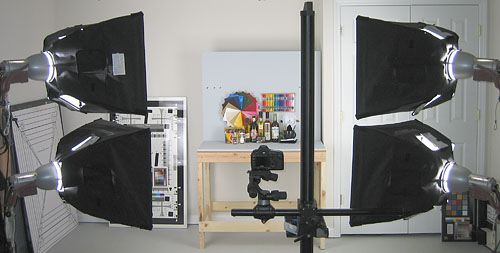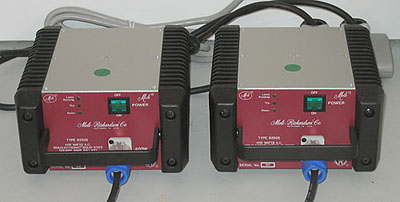We've switched from a dichroic-filtered, gel-diffused incandescent lighting setup, built around SoLux bulbs, to a sophisticated HMI (Hydrargyrum Medium-arc Iodide) setup.
The original SoLux lights were an excellent solution for our shooting needs, and were more affordable. But changing bulbs and re-balancing the illumination was a tedious, painful process, and the diffusion gels we used to achieve even illumination introduced a slight color shift toward warmer tones.
HMI lights are widely used in the television and movie industries to simulate daylight, or to provide daylight-balanced fill lighting outdoors. Unfortunately, they're very expensive, and they produce emission spikes that we thought might cause metamerism with our test subjects.
A little research revealed that most, if not all camera makers rely on HMIs for their simulated daylight. It appears that the emission spikes we were worried about are sufficiently narrow that they don't cause metameric problems with the vast majority of naturally-occurring subjects, and the color spectrum otherwise is an excellent match for natural daylight.
To achieve proper intensity and color control, HMI lamps require a fairly complex electronic ballast, driving up the price considerably. Demand is also largely limited to the movie and TV industries, so there's no mass market out there to pull the prices down.
After some searching, we did find what appeared to be one of the best deals on the market, the Digi-Mole 400 units by Mole-Richardson. Combined with Photoflex SilverDome NXT softboxes and Manfrotto wall booms, we have created a simple and compact solution for illuminating our lab test targets.

The shot above shows the new light setup in our test lab, with a total of four Digi-Moles mounted in four medium SilverDomes, supported by four Manfrotto wall booms. The combination gives us a wash of true ~5500K daylight, balanced to within 0.1EV across our entire target area.

The shot above shows a pair of the Digi-Mole ballasts, powering half of the light setup shown above. They're pretty compact, much smaller than ballasts on other HMI units we've used on occasion. They're cooled via the large black cooling fins on either side, so you need to provide some clearance around the units. They run quite warm (but not hot) to the touch, but are very quiet because they have no fans. There is a slight "singing" sound in the studio from the HMI arcs themselves, but it's not annoying.
As you might gather, this is a pretty dramatic equipment upgrade for the IR test lab, one that we feel really puts at least the lighting of our lab on a par with that of the camera manufacturers themselves. It also creates a dividing line of sorts in our camera testing, as from this point forward, we'll be using this light source in place of the one that we began with, now over eight years ago.
We're sure that our readers will have a lot of questions about this change. We've tried to anticipate as many of them as we could. See our full report on the new HMI lights, complete with FAQ here if you'd like more detail.